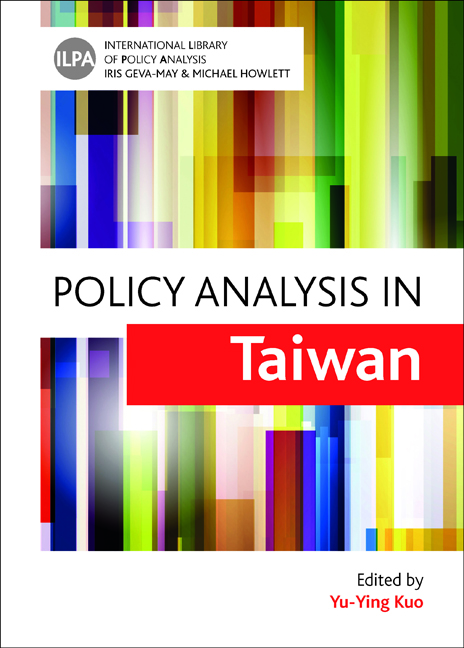Book contents
- Frontmatter
- Contents
- List of tables and figures
- Acknowledgements
- Notes on contributors
- One Policy analysis in a time of turbulence
- Two Exploring policy advisory committees in the central government
- Three Analysis of innovative local government policies in Taiwan
- Four Policy analysis in the legislative body: the legislative process of the Soil and Groundwater Pollution Remediation Act in Taiwan
- Five Policy analysis in the local councils
- Six Gendering policy analysis? The problems and pitfalls of participatory ‘gender impact assessment’
- Seven The power of influencing policies, or getting their share and more: interest groups in Taiwan
- Eight Think tanks in Taiwan
- Nine The development of public engagement in Taiwan
- Ten Social media and policy evolution in Taiwan
- Eleven Policy analysis by non-governmental organisations in Taiwan
- Twelve Policy network of universal healthcare reform in Taiwan
- Thirteen Public policy and administration research
- Fourteen Too critical to ignore? A tri-dimensional relationship examination of policy analysis internship in Taiwan
- Fifteen Policy analysis in Taiwan in an international perspective
- Sixteen Policy analysis education in Taiwan: a comparative perspective
- Index
Six - Gendering policy analysis? The problems and pitfalls of participatory ‘gender impact assessment’
Published online by Cambridge University Press: 11 March 2022
- Frontmatter
- Contents
- List of tables and figures
- Acknowledgements
- Notes on contributors
- One Policy analysis in a time of turbulence
- Two Exploring policy advisory committees in the central government
- Three Analysis of innovative local government policies in Taiwan
- Four Policy analysis in the legislative body: the legislative process of the Soil and Groundwater Pollution Remediation Act in Taiwan
- Five Policy analysis in the local councils
- Six Gendering policy analysis? The problems and pitfalls of participatory ‘gender impact assessment’
- Seven The power of influencing policies, or getting their share and more: interest groups in Taiwan
- Eight Think tanks in Taiwan
- Nine The development of public engagement in Taiwan
- Ten Social media and policy evolution in Taiwan
- Eleven Policy analysis by non-governmental organisations in Taiwan
- Twelve Policy network of universal healthcare reform in Taiwan
- Thirteen Public policy and administration research
- Fourteen Too critical to ignore? A tri-dimensional relationship examination of policy analysis internship in Taiwan
- Fifteen Policy analysis in Taiwan in an international perspective
- Sixteen Policy analysis education in Taiwan: a comparative perspective
- Index
Summary
Introduction
Since the adoption of the Beijing Platform for Action in the Fourth World Conference on Women in 1995, gender mainstreaming (GM) has arguably become the most popular innovation among national governments all over the world for promoting gender equality (Woodward, 2003). GM reflects two important ‘paradigm shifts’ in terms of international frameworks for improving women's rights. One is ‘from women to gender’ – that is, the shift from efforts to eliminate discrimination against women, to targeting the gendered power structure in society (Taylor, 1999). The other shift is ‘from women's units to the mainstream’– that is, demanding that all government departments (not just the traditional ‘soft’ departments) include gender considerations in their policies and plans. This is to be coordinated by a gender machinery that is placed at the highest level of the central government.
In the GM process, a platform for public consultation or participation is often established under the highest-level machinery (such as a gender advisory committee under the President or at the cabinet level) to lead the direction of gender reforms. Many gender scholars, experts and representatives of non-governmental organisations (NGOs) who advocate GM hence provide their support to and work collaboratively with the state. As Tiessen (2007) argued, GM is based on the social partnership established between the government and civil society actors.
In Taiwan, ‘Gender Mainstreaming Implementation Plans’ have been implemented in all ministries and agencies of the Executive Yuan since 2006, and six gender mainstreaming tools – gender equality task force, gender impact assessment, gender analysis, gender statistics, gender budgets and gender-consciousness empowerment – have been developed to embed gender perspectives into all policies, laws and plans. These tools, as is the case in other countries, were developed mainly by gender experts and NGOs in collaboration with government bureaucrats, and hence were characterised by their participatory nature.
These six GM tools can be considered policy analysis tools in a broad sense, as their ultimate purpose is to increase the gender sensitivity and inclusivity of all governmental policies and programmes. Among the tools, Gender Impact Assessment (GIA) is the most widely used having the most resources and legal authorisation.
- Type
- Chapter
- Information
- Policy Analysis in Taiwan , pp. 81 - 94Publisher: Bristol University PressPrint publication year: 2015

